Are you curious about the vibrant and colorful decorations that embody the spirit of Mexico? At gaymexico.net, we’ll take you on a journey through the heart of Mexican culture, highlighting the iconic decorations that bring joy and festivity to every celebration, perfect for LGBTQ+ travelers and those seeking authentic cultural experiences. Explore the best Mexican souvenirs, festive decor, and cultural keepsakes.
1. Maracas: The Rhythm of Mexican Celebrations
Are maracas a common sight in Mexican celebrations? Yes, maracas are a traditional toy and musical instrument in Mexico, widely used, especially by children, during celebrations to create lively rhythms. These colorful shakers add a fun and festive element to any event, embodying the joyful spirit of Mexican culture.
Maracas are not just noise-makers; they’re a symbol of Mexican heritage and festivity. Originating from pre-Columbian times, they were initially made from gourds filled with dried beans or seeds. Today, they’re crafted from various materials, including wood and plastic, and painted in bright, eye-catching colors. According to the Smithsonian Institution, indigenous communities in Latin America have long used maracas in rituals and celebrations, connecting them to cultural identity and expression.
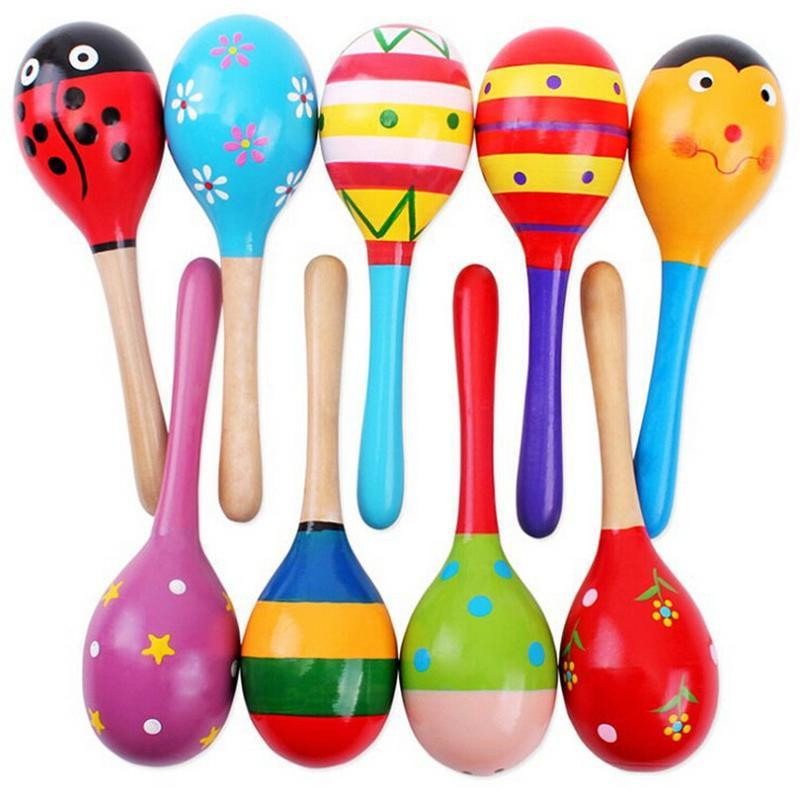 Colorful wooden maracas for sale in Mexico
Colorful wooden maracas for sale in Mexico
2. Papel Picado: The Art of Festive Paper Cutting
What makes papel picado such a beloved Mexican decoration? Papel picado, meaning “perforated paper,” is a quintessential Mexican decoration used to brighten up celebrations with its intricate designs and vibrant colors. These delicate paper banners add a touch of elegance and festivity to any event.
Papel picado is more than just decoration; it’s an art form steeped in history and tradition. Originating in the early 19th century, this craft involves cutting elaborate designs into tissue paper, creating banners that depict everything from flowers and birds to skeletons and religious figures. According to the Mexican Folk Art Guide, the tradition may have evolved from Chinese paper cutting techniques introduced during the colonial era. Papel picado is particularly prominent during Día de los Muertos (Day of the Dead), where it symbolizes the fragility of life and the connection between the living and the dead.
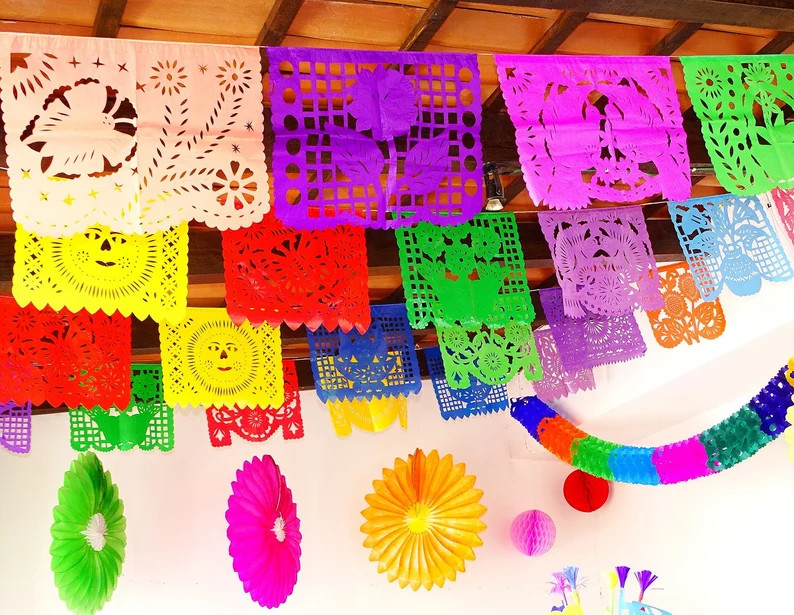 Intricate papel picado banners hanging as a Mexican decoration
Intricate papel picado banners hanging as a Mexican decoration
3. Mariachi Hats: A Symbol of Mexican Musical Heritage
Why are mariachi hats considered iconic Mexican decorations? Mariachi hats, or sombreros, are iconic symbols of Mexican musical heritage. Adorned with intricate embroidery and vibrant colors, these hats add an authentic and fun touch to any celebration.
The mariachi hat is more than just an accessory; it represents the rich cultural traditions of mariachi music. Originating in the state of Jalisco, mariachi music is a symbol of Mexican identity and pride. The sombrero, with its wide brim and ornate detailing, is an integral part of the mariachi ensemble. According to UNESCO, mariachi music was added to its list of Intangible Cultural Heritage in 2011, recognizing its cultural significance. The hats, often customized with unique designs and colors, reflect the individuality of each mariachi musician and their group.
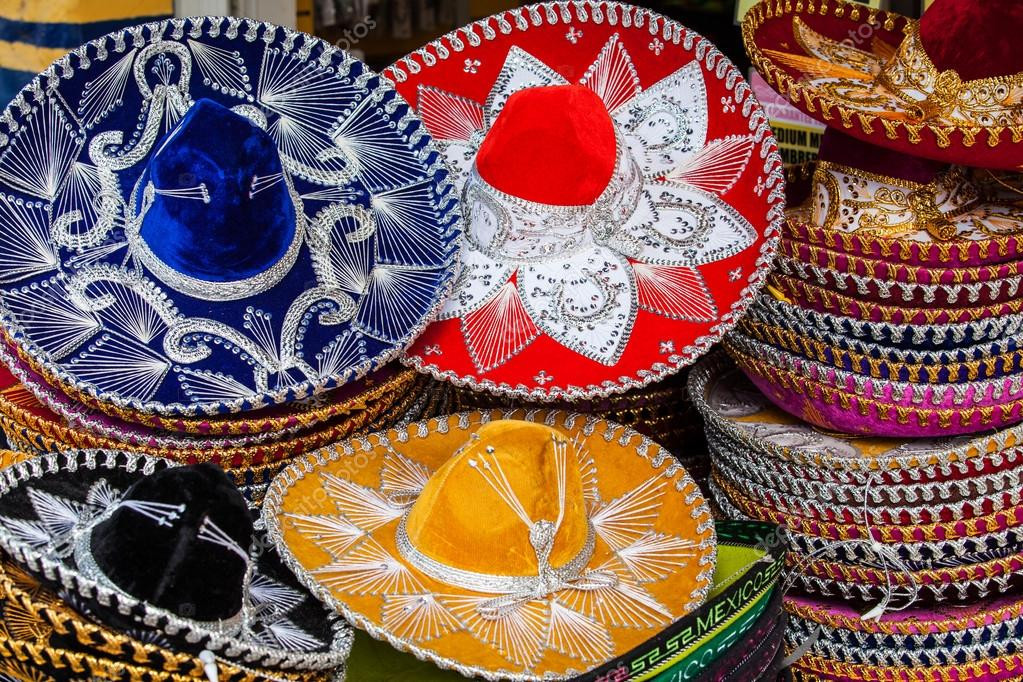 A colorful Mexican sombrero, a popular souvenir and decoration
A colorful Mexican sombrero, a popular souvenir and decoration
4. Small Mexican Guitars: Melodies in Miniature
How do small Mexican guitars enhance festive decorations? Small Mexican guitars, often exquisitely crafted, add an original and charming touch to any celebration. These miniature instruments serve as excellent souvenirs and decorative pieces.
These small guitars, also known as guitarrillas, are often handmade and painted with bright colors and intricate designs. They serve as a reminder of Mexico’s rich musical heritage, particularly its tradition of mariachi and son music. According to the National Museum of Mexican Art, these miniature instruments are often given as gifts to children or used as decorative items in homes and businesses, symbolizing the importance of music in Mexican culture.
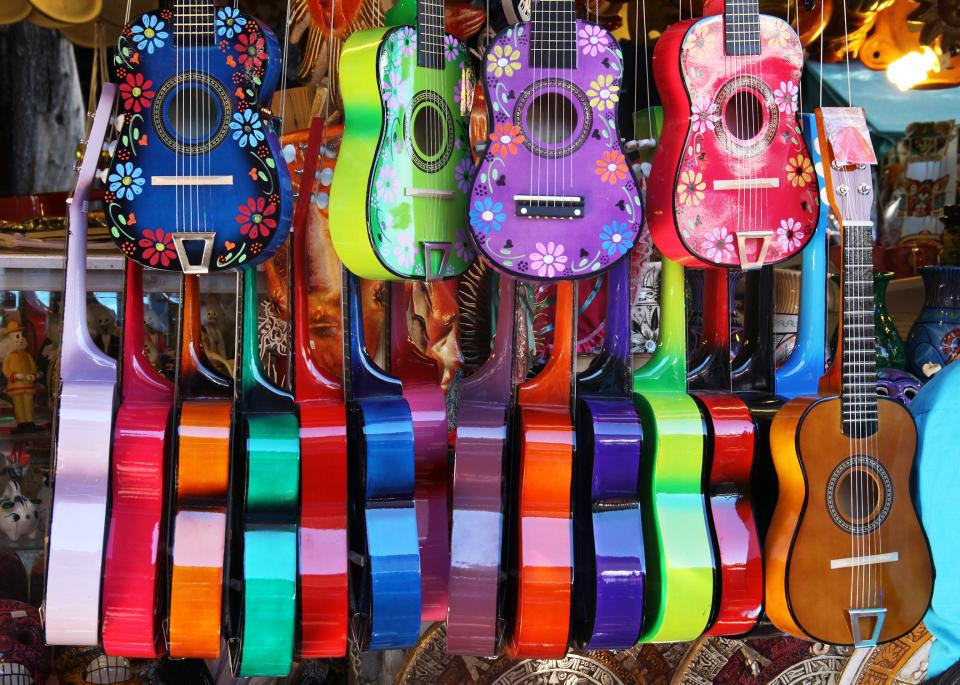 A small Mexican guitar adding a cultural touch to decorations
A small Mexican guitar adding a cultural touch to decorations
5. Adelita Dolls: Celebrating Women of the Revolution
What is the significance of Adelita dolls in Mexican decor? Adelita dolls, named after the women who fought in the Mexican Revolution, are excellent decorations for home celebrations. These dolls add a special touch of history and culture to any setting.
Adelita dolls pay homage to the brave women who played a crucial role in the Mexican Revolution of the early 20th century. These women, often referred to as soldaderas, fought alongside men, providing support, nursing the wounded, and even taking up arms themselves. According to Elena Poniatowska’s “Las Soldaderas,” these women were essential to the revolutionary effort, embodying courage and resilience. The dolls, dressed in traditional revolutionary attire, serve as a reminder of their contribution to Mexican history and culture.
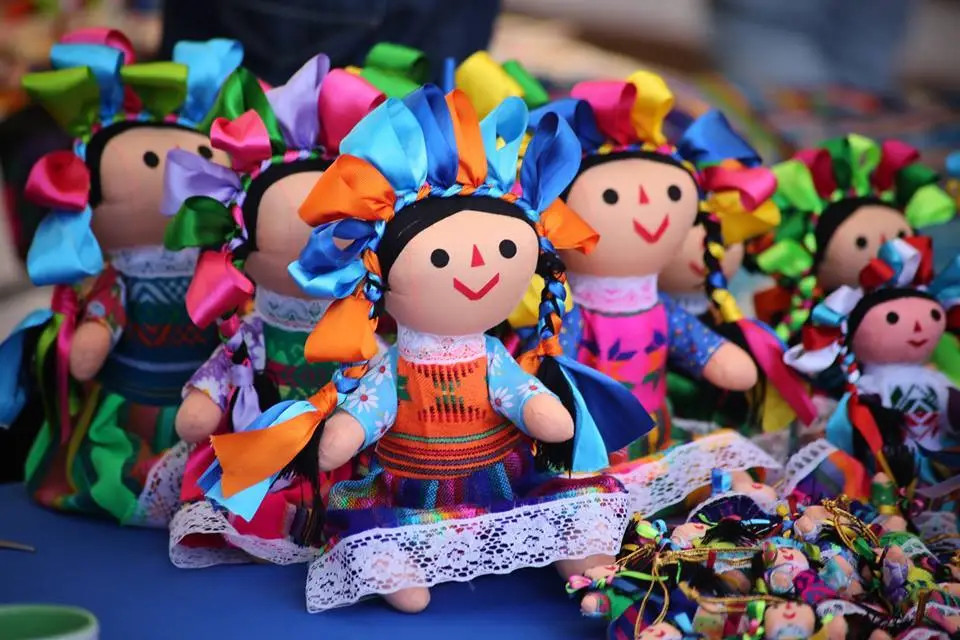 An Adelita doll, a decorative symbol of Mexican history
An Adelita doll, a decorative symbol of Mexican history
6. Mexican Sarapes: A Blanket of Cultural Richness
Why are Mexican sarapes a versatile decorative item? The sarape is a versatile textile that can be used as a souvenir, a gift, or a table runner, perfect for adding a touch of Mexican flair to any celebration. Its vibrant colors and intricate patterns make it a standout decorative item.
Sarapes, also known as jorongos, are traditional Mexican blankets that have been woven for centuries. These textiles are typically made from wool and are known for their bold colors and intricate designs, which often include geometric patterns, floral motifs, and images of animals. According to Artes de México, the sarape originated in the state of Coahuila and was originally worn by men as a poncho or cloak. Today, sarapes are used for a variety of purposes, from blankets and rugs to wall hangings and upholstery, adding a touch of Mexican warmth and style to any space.
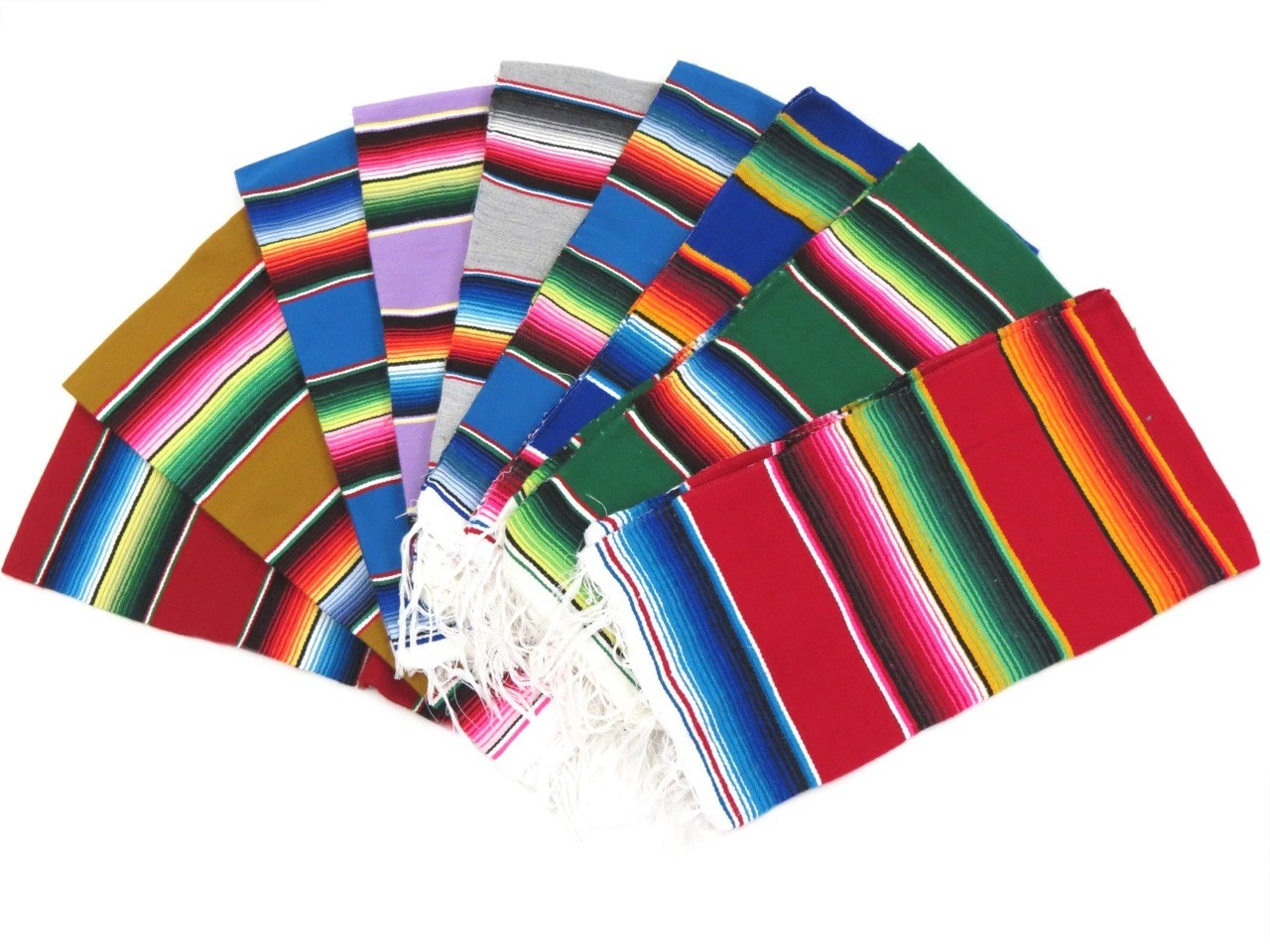 A colorful Mexican sarape, ideal as a decoration or gift
A colorful Mexican sarape, ideal as a decoration or gift
7. Beaded Necklaces: Adding Sparkle to the Fiesta
How do beaded necklaces contribute to a festive atmosphere in Mexico? Beaded necklaces are perfect for Mexican celebrations, adding a fun and colorful touch to the party atmosphere. They make excellent gifts for friends, ensuring everyone gets into the celebratory mood.
Beaded necklaces, often made from brightly colored beads and adorned with charms and pendants, are a popular accessory during Mexican fiestas. These necklaces add a touch of sparkle and fun to any outfit, and they are often given as party favors to guests. According to the Museum of Beadwork, beadwork has a long history in Mexico, dating back to pre-Columbian times when indigenous artisans used beads made from shells, seeds, and stones to create intricate jewelry and adornments. Today, beaded necklaces are a vibrant expression of Mexican culture and festivity.
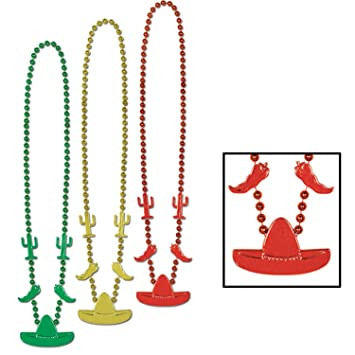 Colorful beaded necklaces, perfect for a Mexican fiesta
Colorful beaded necklaces, perfect for a Mexican fiesta
8. Day of the Dead Decorations: Honoring Ancestors with Color and Life
What kind of decorations are prominent during the Day of the Dead in Mexico? Day of the Dead decorations are prominent during the Día de los Muertos, a celebration that honors deceased loved ones with vibrant color and life. These decorations include ofrendas, sugar skulls, and marigolds, creating a festive yet reverent atmosphere.
Día de los Muertos is a unique and deeply meaningful celebration in Mexico, blending indigenous beliefs with Catholic traditions. During this holiday, families create elaborate altars, or ofrendas, to honor their deceased loved ones. These altars are adorned with photographs, favorite foods and drinks, and personal belongings of the deceased. According to the National Endowment for the Arts, marigolds, known as cempasúchil in Mexico, are the flowers most commonly associated with Día de los Muertos, their vibrant orange color believed to guide the spirits of the dead back to their families. Sugar skulls, or calaveras de azúcar, are another iconic symbol of the holiday, often decorated with colorful icing and personalized with the names of the deceased.
9. Piñatas: A Burst of Fun and Tradition
What role do piñatas play in Mexican celebrations? Piñatas are a staple of Mexican celebrations, especially during birthday parties and holidays. Filled with candy and toys, breaking a piñata is a fun and exciting activity for children and adults alike.
The piñata has a long and colorful history in Mexico, dating back to pre-Columbian times when indigenous cultures used clay pots filled with offerings for their gods. According to the Catholic News Agency, Spanish missionaries adapted this tradition in the 16th century, using the piñata as a tool for evangelization. The original piñata had seven points, representing the seven deadly sins, and breaking it symbolized the triumph of good over evil. Today, piñatas come in a variety of shapes and sizes, from traditional star shapes to popular cartoon characters, and they are a beloved part of Mexican celebrations.
10. Mexican Flags and Banners: Pride and Patriotism on Display
Why are Mexican flags and banners common decorations? Mexican flags and banners are common decorations during national holidays and patriotic events. These symbols of national pride are displayed in homes, businesses, and public spaces, fostering a sense of unity and celebration.
The Mexican flag, with its distinctive green, white, and red colors and its iconic emblem of an eagle devouring a serpent, is a powerful symbol of Mexican identity and sovereignty. According to the Mexican government, the flag represents the country’s history, culture, and values. During national holidays, such as Independence Day on September 16th, the flag is prominently displayed throughout the country, along with colorful banners and streamers. These decorations create a festive atmosphere and remind Mexicans of their shared heritage and national pride.
11. Religious Imagery: Faith and Spirituality in Mexican Homes
How does religious imagery influence Mexican decorations? Religious imagery, such as depictions of the Virgin of Guadalupe and other saints, is a common feature in Mexican homes and decorations. These symbols of faith and spirituality reflect the country’s deep-rooted Catholic traditions.
Mexico has a long and rich history of religious art and iconography, dating back to the colonial era when Spanish missionaries introduced Catholicism to the indigenous population. According to the Encyclopedia of Latin American History and Culture, the Virgin of Guadalupe, who is considered the patron saint of Mexico, is one of the most revered religious figures in the country. Images of the Virgin, along with other saints and religious symbols, are commonly displayed in homes, churches, and public spaces, serving as a reminder of faith and spirituality in everyday life.
12. Pottery and Ceramics: Artistic Expressions in Clay
What types of pottery and ceramics are used for decoration in Mexico? Pottery and ceramics are widely used for decoration in Mexico, showcasing the country’s rich artistic traditions. From colorful Talavera pottery to rustic terracotta pots, these pieces add a touch of Mexican charm to any space.
Mexico has a long and rich history of pottery and ceramics, dating back to pre-Columbian times when indigenous cultures used clay to create vessels, figurines, and other objects. According to the Museo Nacional de Antropología, each region of Mexico has its own unique style of pottery, reflecting the local materials, techniques, and artistic traditions. Talavera pottery, which originated in the city of Puebla, is known for its vibrant colors and intricate designs, while terracotta pottery, which is made from reddish-brown clay, is valued for its rustic charm. These pieces are used for a variety of purposes, from serving food and drinks to decorating homes and gardens.
13. Textiles and Embroidered Art: Weaving Stories in Fabric
How do textiles and embroidered art contribute to Mexican decor? Textiles and embroidered art are integral to Mexican decor, adding warmth, color, and cultural richness to homes and celebrations. These handcrafted pieces often tell stories and reflect the unique traditions of different regions.
Mexico has a long and rich tradition of textile art, dating back to pre-Columbian times when indigenous cultures used natural fibers to create clothing, blankets, and other textiles. According to the Textile Museum of Oaxaca, each region of Mexico has its own unique style of weaving and embroidery, reflecting the local materials, techniques, and artistic traditions. Embroidered textiles, which are often adorned with colorful threads and intricate designs, are used for a variety of purposes, from clothing and bedding to wall hangings and table runners. These pieces are valued for their beauty, craftsmanship, and cultural significance, adding a touch of Mexican warmth and style to any space.
14. Festive Lighting: Illuminating Mexican Celebrations
What types of lighting are used to create a festive atmosphere in Mexico? Festive lighting plays a crucial role in creating a celebratory atmosphere in Mexico, especially during holidays and festivals. From string lights and lanterns to candles and luminaries, these sources of illumination add warmth, color, and magic to any event.
Mexico has a long and rich tradition of using lighting to create a festive atmosphere, dating back to pre-Columbian times when indigenous cultures used torches and bonfires to celebrate religious and seasonal events. According to the Getty Research Institute, string lights, or luces de feria, are a popular decoration during Mexican holidays, adding a touch of sparkle and whimsy to homes, businesses, and public spaces. Lanterns, which are often made from paper or tin, are another common decoration, casting a warm and inviting glow. Candles and luminaries, which are often used during Día de los Muertos, create a reverent and spiritual atmosphere, honoring the memory of deceased loved ones.
15. Nativity Scenes: Celebrating Christmas in Mexico
How are nativity scenes incorporated into Mexican Christmas decorations? Nativity scenes, or nacimientos, are an integral part of Mexican Christmas decorations, depicting the birth of Jesus in a humble manger. These elaborate displays are set up in homes, churches, and public spaces, celebrating the spirit of the holiday.
Mexico has a long and rich tradition of creating nativity scenes, dating back to the colonial era when Spanish missionaries introduced the custom to the indigenous population. According to the University of Dayton, Mexican nativity scenes are often more elaborate and colorful than those found in other countries, featuring a wide range of figures and details. In addition to the traditional figures of Mary, Joseph, and the baby Jesus, Mexican nativity scenes may also include shepherds, angels, animals, and even scenes from everyday life. These displays are a beloved part of Mexican Christmas traditions, bringing joy and wonder to people of all ages.
16. Balloons: Adding a Pop of Color to Celebrations
What is the role of balloons in Mexican celebrations? Balloons add a pop of color and fun to Mexican celebrations, especially during birthday parties and festive events. Available in various shapes, sizes, and colors, they are a versatile and affordable way to decorate any space.
Balloons have become an increasingly popular decoration in Mexico in recent years, adding a touch of whimsy and festivity to celebrations of all kinds. According to the International Balloon Association, balloons are often used to decorate birthday parties, weddings, and corporate events, creating a cheerful and celebratory atmosphere. In Mexico, balloons are often adorned with colorful ribbons and streamers and are sometimes shaped into arches or other decorative displays. They are a versatile and affordable way to add a pop of color and fun to any event.
17. Banderitas: Festive Flags for Celebratory Occasions
What are banderitas and how are they used in Mexican decorations? Banderitas, or small flags, are a festive decoration widely used in Mexican celebrations. These colorful flags are strung together to create banners, adding a vibrant and cheerful touch to any event.
Banderitas are a simple yet effective decoration that is commonly used in Mexico to celebrate a variety of occasions, from national holidays to birthday parties. According to the Mexican government, banderitas are often made from brightly colored plastic or paper and are strung together to create long banners that are hung across streets, plazas, and homes. These flags add a touch of festivity and cheer to any event, and they are a beloved part of Mexican traditions.
18. Streamers: Adding Movement and Color to Decorations
How do streamers enhance the visual appeal of Mexican decorations? Streamers add movement and color to Mexican decorations, creating a dynamic and festive atmosphere. These colorful ribbons are often hung from ceilings, walls, and trees, adding a touch of whimsy and cheer to any event.
Streamers are a versatile decoration that can be used in a variety of ways to enhance the visual appeal of Mexican celebrations. According to the Association of Party and Event Professionals, streamers are often made from crepe paper or plastic and are available in a wide range of colors and patterns. They can be hung from ceilings, walls, and trees, creating a dynamic and festive atmosphere. Streamers are also often used to decorate tables, chairs, and other surfaces, adding a touch of color and cheer to any event.
19. Confetti: A Shower of Celebration
Why is confetti a popular element in Mexican festivities? Confetti is a popular element in Mexican festivities, adding a shower of color and excitement to celebrations of all kinds. Thrown during parades, parties, and other events, confetti creates a joyful and memorable experience.
Confetti has a long and rich history in Mexico, dating back to pre-Columbian times when indigenous cultures used feathers, flower petals, and other natural materials to celebrate religious and seasonal events. According to the Smithsonian Latino Center, confetti is often made from brightly colored paper or plastic and is thrown during parades, parties, and other events, creating a joyful and memorable experience. In Mexico, confetti is often associated with celebrations of love and happiness, such as weddings and quinceañeras.
20. Lucha Libre Masks: The Colorful World of Mexican Wrestling
How do Lucha Libre masks contribute to the cultural aesthetic of Mexico? Lucha Libre masks, inspired by the colorful world of Mexican wrestling, are a unique and eye-catching decoration. These masks represent the masked wrestlers, or luchadores, and are a symbol of Mexican pop culture.
Lucha Libre, or Mexican wrestling, is a unique and beloved sport that combines athleticism, theater, and mythology. According to the book “Masked Culture: The Greenwich Village Halloween Parade,” the masks worn by luchadores are an integral part of the sport, representing the wrestler’s identity, personality, and values. Lucha Libre masks are often brightly colored and adorned with intricate designs, and they are a popular souvenir and decoration in Mexico. They represent the colorful world of Mexican wrestling and are a symbol of Mexican pop culture.
Gaymexico.net invites you to explore these decorations further and discover how they contribute to the rich tapestry of Mexican culture, particularly within the LGBTQ+ community.
For more insights and information, feel free to contact us:
- Address: 3255 Wilshire Blvd, Los Angeles, CA 90010, United States
- Phone: +1 (213) 380-2177
- Website: gaymexico.net
FAQ: Mexican Decorations
1. What are the most common decorations used during Mexican Independence Day celebrations?
The most common decorations include Mexican flags, papel picado, mariachi hats, and tricolor streamers. These items showcase national pride and create a festive atmosphere.
2. Can you explain the significance of sugar skulls in Day of the Dead celebrations?
Sugar skulls, or calaveras de azúcar, symbolize deceased loved ones and are placed on altars as offerings. They are often decorated with colorful icing and personalized with names.
3. What is the history behind papel picado, and why is it used in celebrations?
Papel picado is a traditional Mexican folk art involving intricate paper cuttings. It’s used to brighten celebrations, symbolizing the fragility of life and the connection between the living and the dead.
4. How are maracas traditionally used in Mexican culture?
Maracas are traditional musical instruments used to create lively rhythms during celebrations. They are often played by children and add a fun, festive element to any event.
5. What materials are commonly used to make Mexican decorations?
Common materials include paper, wood, fabric, beads, and clay. These materials reflect the country’s rich artistic traditions and cultural heritage.
6. What is the role of religious imagery in Mexican decor?
Religious imagery, such as depictions of the Virgin of Guadalupe, is a common feature in Mexican homes, reflecting the country’s deep-rooted Catholic traditions and spirituality.
7. How do textiles and embroidered art contribute to Mexican decor?
Textiles and embroidered art add warmth, color, and cultural richness to Mexican homes and celebrations. These handcrafted pieces often tell stories and reflect the traditions of different regions.
8. What are some popular themes or motifs found in Mexican decorations?
Popular themes include flowers, animals, religious figures, and geometric patterns. These motifs reflect the country’s rich cultural heritage and artistic traditions.
9. How do Lucha Libre masks contribute to the cultural aesthetic of Mexico?
Lucha Libre masks represent the masked wrestlers, or luchadores, and are a symbol of Mexican pop culture. They add a unique and eye-catching element to the cultural aesthetic of Mexico.
10. What types of lighting are commonly used to create a festive atmosphere in Mexico?
Festive lighting, such as string lights, lanterns, candles, and luminaries, adds warmth, color, and magic to Mexican celebrations, creating a vibrant and inviting atmosphere.
Ready to immerse yourself in the vibrant culture of Mexico? Visit gaymexico.net for comprehensive travel guides, LGBTQ+ friendly destinations, and community insights! Explore Mexico safely and authentically, connect with local communities, and discover unforgettable experiences today.
